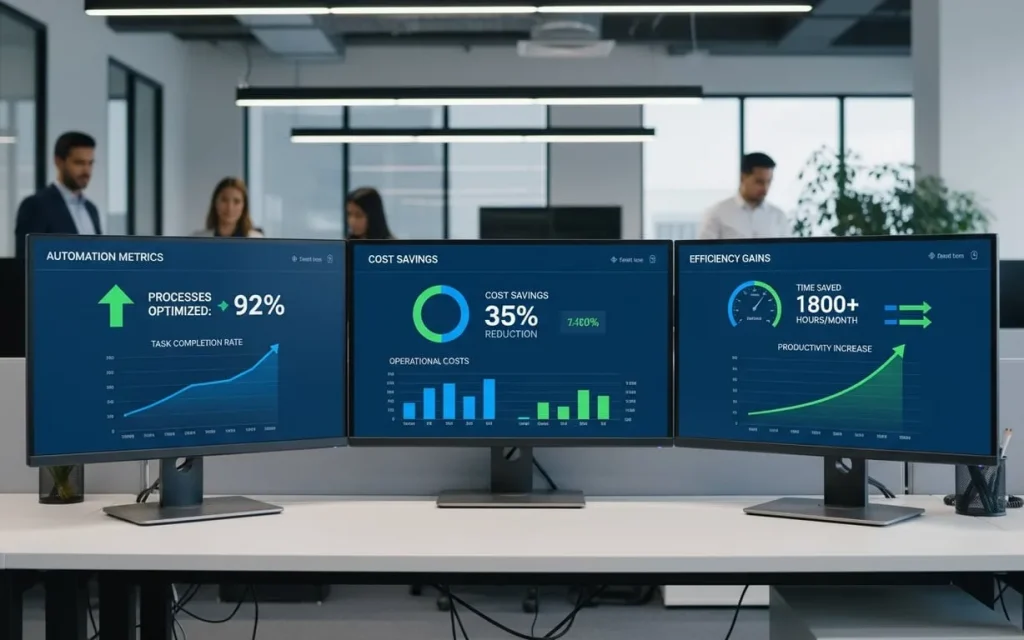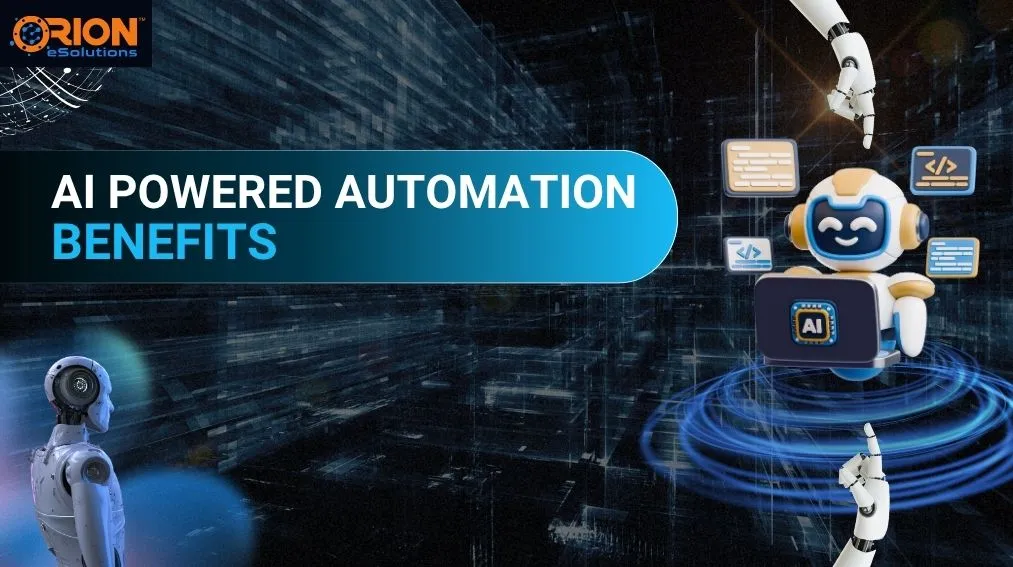What is AI Powered Automation and How Does it Work
The fusion of artificial intelligence with automation technologies has ushered in a transformative era for business operations, surpassing the capabilities of traditional automated systems. AI- powered automation marks a significant departure from rigid, rule-based processes, introducing intelligent systems capable of learning, adapting, and making real-time decisions. But how does this technology actually function? At its core, AI automation leverages machine learning and data analytics to enhance and streamline existing workflows, offering a dynamic alternative to static automation. For businesses looking to implement these advanced capabilities, specialized AI development services can provide tailored solutions.
Unlike conventional automation, which adheres to predetermined scripts and workflows, AI-driven automation uses machine learning algorithms, natural language processing, and predictive analytics to manage complex scenarios that typically demand human involvement. These systems are equipped to process both structured and unstructured data, identify patterns, and continuously refine their performance based on past outcomes and incoming information.

The operational structure of AI and automation starts with extensive data collection from diverse sources throughout an organization. Machine learning models then analyze this data to spot trends, detect anomalies, and forecast future scenarios. The insights derived from this analysis empower automated systems to perform tasks with greater accuracy and flexibility than traditional methods.
A key feature of machine learning automation is its capacity for evolution. Traditional systems require manual updates and reprogramming when conditions change. AI-powered solutions, however, automatically adjust their algorithms based on new data patterns and results. This self- improving capability ensures that these systems become more effective and precise over time, lessening the need for constant human supervision and upkeep.
The integration of artificial intelligence into automation workflows results in systems that can navigate ambiguous situations, make context-aware decisions, and even anticipate potential problems. This proactive approach transforms reactive business processes into intelligent, forward- looking operations capable of adapting to shifting market conditions and evolving organizational needs.
This adaptability is further amplified when AI is combined with robotic process automation, leading to even more sophisticated applications.
Robotic process automation enhanced with artificial intelligence
The advancement of robotic process automation through the incorporation of artificial intelligence has led to intelligent process automation, marking a substantial improvement in business process capabilities. Traditional RPA excels at performing repetitive, rule-based tasks with accuracy and speed. However, its limitations become apparent when processes require decision- making or the handling of unstructured data.

When enhanced with AI, robotic process automation evolves from a basic task executor into an intelligent decision-maker. These advanced systems can interpret documents, understand context, and make complex judgments that previously needed human input. This integration enables end-to- end process automation that manages exceptions, variations, and unexpected scenarios without failing or needing manual intervention.
Examples of intelligent process automation illustrate this enhanced capability across various business functions. AI-powered systems can analyze invoice data, cross-reference it with purchase orders and contracts, identify discrepancies, and route exceptions to the appropriate personnel for review. Similarly, customer service automation can understand natural language inquiries, determine intent, provide relevant responses, or escalate complex issues to human agents.
The key difference in AI business process automation is its learning capability. While traditional RPA follows static rules, AI-enhanced systems continuously learn from each interaction, improving their accuracy and expanding their ability to handle new scenarios. This learning process creates a feedback loop where the system becomes more valuable over time, reducing the total cost of ownership and increasing the return on investment.
Machine learning algorithms within these systems can identify patterns in process variations, suggest optimizations, and even predict when processes might fail or require attention. This predictive capability transforms reactive maintenance into proactive process management, significantly improving operational efficiency and reducing downtime.
The integration of AI into business processes not only enhances RPA but also unlocks a range of benefits that extend far beyond mere automation.
Artificial intelligence benefits for automated business processes
Integrating artificial intelligence into automated business processes provides significant advantages that go beyond simple task completion. These benefits fundamentally change how organizations operate, compete, and deliver value to their customers and stakeholders.
One of the most notable benefits is the substantial improvement in processing speed and accuracy. AI-powered systems can manage numerous transactions simultaneously while maintaining consistent quality. Unlike human workers, who may tire or become distracted, these systems maintain peak performance, processing complex data sets and making decisions in milliseconds rather than minutes or hours.
Business process automation benefits are particularly evident in cost reduction and resource optimization. Organizations that implement AI-driven automation report considerable decreases in operational expenses. These savings come from reduced manual labor, fewer errors needing correction, and improved resource allocation based on predictive analytics.
The benefits of intelligent automation extend to risk management and compliance. AI systems can continuously monitor processes for compliance violations, detect anomalies that might indicate fraud or errors, and ensure consistent application of business rules across all transactions. This capability is especially valuable in regulated industries where compliance failures can lead to significant penalties and damage to reputation.
Perhaps most importantly, AI-enhanced automated business processes allow human workers to focus on strategic, creative, and relationship-building activities that drive innovation and growth.
Instead of spending time on repetitive data entry or routine decision-making, employees can concentrate on problem-solving, customer engagement, and strategic planning that adds real value to the organization.
The scalability of AI-powered automation is also a key advantage. Traditional processes often require proportional increases in staff and resources to handle growth, but intelligent automation systems can scale to manage increased volumes with minimal additional investment. This scalability enables organizations to grow more efficiently and respond quickly to market opportunities without the constraints of traditional resource limitations.
Quality improvements are another crucial benefit. AI systems can maintain consistent standards across all processes while identifying opportunities for optimization. These systems learn from each interaction, continuously refining their approaches to deliver better outcomes and higher customer satisfaction.
These benefits are further amplified when AI is integrated into workflow automation, enhancing productivity and streamlining operations.
Workflow automation powered by AI productivity tools
The field of AI-powered workflow automation has been transformed by the introduction of advanced AI productivity tools that change how teams collaborate, make decisions, and manage complex projects. These AI-powered tools move beyond basic task automation to create intelligent workflows that adapt to changing conditions and optimize themselves based on performance data.
Modern AI productivity tools integrate into existing business environments, analyzing workflow patterns and identifying bottlenecks or inefficiencies that might not be obvious to human observers. These systems can automatically route tasks to the most suitable team members based on workload, expertise, and availability, ensuring optimal resource use and faster project completion.
The strength of AI-driven tools lies in their ability to learn from past workflow data and predict future needs. For example, these systems can anticipate when certain resources will be needed, automatically schedule meetings based on project milestones, and even suggest process improvements based on successful patterns from similar projects. This predictive capability turns reactive workflow management into proactive optimization.
Workflow automation enhanced by artificial intelligence also improves communication and collaboration across teams. AI-powered tools can automatically generate status reports, summarize meeting notes, track project progress, and alert stakeholders to potential issues before they become critical. This automated communication ensures that everyone stays informed without manual reporting and status updates.
The integration of natural language processing in these AI-powered tools allows for more intuitive interaction with automated systems. Team members can use conversational interfaces to check project status, request resources, or modify workflows without needing technical skills. This accessibility makes automation more user-friendly, allowing non-technical users to benefit from sophisticated AI capabilities.
These intelligent systems also excel at managing complex approval processes and decision trees that traditionally required significant manual coordination. AI-driven tools can automatically route requests through appropriate approval chains, escalate urgent items, and ensure compliance with organizational policies and procedures, all while maintaining detailed audit trails for accountability and compliance.
The integration of AI into workflow automation not only enhances productivity but also leads to significant cost savings and efficiency gains for businesses.
Automation in business – cost savings and efficiency gains
Implementing automation in business environments provides measurable financial benefits and operational improvements that directly affect an organization’s profitability and competitive position. Solutions like OrionERP Software are designed to deliver these advantages across multiple aspects of business operations, from direct cost reductions to strategic capability enhancements.

Direct cost savings from business automation typically come from reduced labor costs for routine tasks, lower error rates that eliminate costly corrections, and better resource use. Organizations often report cost savings of 25-50% in specific process areas, with some achieving even higher reductions in highly repetitive functions like data processing, invoice handling, and customer service inquiries.
The benefits of automation extend beyond immediate cost reductions to include significant efficiency gains that increase over time. Automated systems can process transactions 24/7 without breaks, holidays, or sick days, effectively increasing organizational capacity without proportional increases in overhead costs. This continuous operation enables businesses to handle higher volumes, respond faster to customer needs, and capture opportunities that might otherwise be missed due to resource constraints.
Automation tools also deliver substantial improvements in process consistency and quality. Human error rates in repetitive tasks can range from 1-5%, while well-designed automated systems typically achieve error rates below 0.1%. This improvement in accuracy reduces the costs associated with error correction, customer complaints, and regulatory compliance issues, while simultaneously improving customer satisfaction and brand reputation.
The strategic value of automation becomes clear in its ability to enable rapid scaling without proportional increases in operational complexity or costs. Organizations can expand their operations,
enter new markets, or launch new products more quickly when supported by robust automation infrastructure. This scalability is particularly valuable in competitive markets where speed to market and operational efficiency determine success.
Perhaps most significantly, automation frees human resources to focus on high-value activities that drive innovation and growth. When routine tasks are handled automatically, employees can concentrate on strategic planning, creative problem-solving, customer relationship building, and other activities that directly contribute to competitive advantage and long-term success.
The return on investment for automation initiatives typically becomes positive within 12-18 months, with benefits continuing to increase as systems mature and expand.
To fully realize these benefits, selecting the right AI automation platforms and implementation strategies is crucial.
AI automation platforms and implementation strategies
Selecting and implementing the right AI automation platforms requires a strategic approach that aligns technology capabilities with organizational needs and long-term business objectives. The success of these initiatives depends heavily on careful planning, stakeholder engagement, and a clear understanding of both current processes and desired future states.
The evaluation of AI automation platforms should begin with a comprehensive assessment of existing business processes and identification of automation opportunities. Organizations need to prioritize processes based on factors such as volume, complexity, error rates, and strategic importance. This analysis helps determine which platform features and capabilities will deliver the greatest value and return on investment.
When considering how to use ai to automate tasks effectively, organizations must evaluate platforms based on their integration capabilities, scalability, ease of use, and support for different types of automation. This often includes considering specialized ERP development for robust enterprise-level solutions. Modern platforms typically offer low-code or no-code development environments that enable business users to create and modify automated workflows without extensive technical expertise, making automation more accessible across the organization.
Implementation strategies should follow a phased approach that begins with pilot projects in well- defined, lower-risk areas. These initial implementations serve as proof-of-concept demonstrations that build organizational confidence and expertise while providing valuable lessons for larger-scale deployments. Successful pilot projects also help identify potential challenges and develop solutions before they impact critical business processes.
The importance of data quality and governance cannot be overstated in AI for task automation initiatives. These systems rely on accurate, consistent data to function effectively, requiring organizations to invest in data cleansing, standardization, and ongoing quality management processes. Establishing clear data governance policies and procedures ensures that automated systems have access to reliable information and can make accurate decisions.
Change management is a critical success factor in automation platform implementations. Organizations must invest in training programs that help employees understand how AI-powered tools will change their roles and responsibilities. Rather than viewing automation as a threat, employees should be positioned to see these tools as enablers that free them to focus on more strategic and fulfilling work.
Successful implementation also requires establishing clear metrics and monitoring systems to track performance, identify issues, and measure return on investment. These monitoring capabilities should include both technical metrics like system performance and error rates, as well as business metrics such as cost savings, efficiency improvements, and customer satisfaction scores.
The practical impact of these platforms and strategies is best illustrated through real-world examples of automation systems across various industries.
Examples of automation systems across industries
The transformative power of AI automation becomes most evident when examining real-world implementations across diverse industries, where organizations have achieved remarkable improvements in efficiency, accuracy, and customer satisfaction through intelligent process automation.
In the manufacturing sector, predictive maintenance systems represent one of the most impactful examples of automation systems. These AI-powered solutions continuously monitor equipment performance, analyzing vibration patterns, temperature fluctuations, and other operational data to predict when maintenance will be required. Companies have implemented such systems across their manufacturing facilities, reducing unplanned downtime and extending equipment life by identifying potential issues before they cause failures.
The healthcare industry has embraced AI automation through diagnostic imaging systems that can analyze medical scans with accuracy levels that match or exceed human radiologists. These systems process numerous images daily, identifying potential abnormalities and prioritizing urgent cases for immediate attention. Additionally, automated patient monitoring systems in intensive care units can predict patient deterioration hours before traditional methods, enabling proactive interventions that save lives and reduce treatment costs.
Financial services organizations have implemented fraud detection systems that analyze transaction patterns in real-time, identifying suspicious activities within milliseconds of occurrence. These examples demonstrate how AI can process millions of transactions simultaneously, applying algorithms to detect patterns that would be impossible for human analysts to identify manually. Banks report fraud detection improvements while reducing false positive rates that previously inconvenienced legitimate customers.
In the retail and e-commerce sector, inventory management systems powered by AI analyze sales patterns, seasonal trends, supplier performance, and external factors like weather and economic conditions to optimize stock levels automatically. These systems can predict demand fluctuations, reducing inventory carrying costs while minimizing stockouts that result in lost sales and customer dissatisfaction.
The logistics and transportation industry has improved route optimization through AI-powered systems that consider real-time traffic conditions, weather patterns, delivery priorities, and vehicle capabilities to create delivery schedules. Companies have implemented these systems to reduce fuel consumption, improve delivery times, and increase customer satisfaction while handling growing package volumes.
Human resources departments across industries have automated recruitment processes using AI systems that can screen resumes, conduct initial candidate assessments, and even schedule interviews based on availability and preferences. These systems can process applications in minutes, identifying the most qualified candidates while eliminating bias that might influence human recruiters.
In the energy sector, smart grid systems use AI automation to balance electricity supply and demand in real-time, automatically adjusting power generation and distribution based on consumption patterns and renewable energy availability. These systems optimize energy efficiency while maintaining grid stability, reducing costs for both utilities and consumers.
Customer service operations across industries have been transformed by AI-powered chatbots and virtual assistants that can handle routine inquiries, process simple transactions, and escalate complex issues to human agents when necessary. These systems provide availability while maintaining consistent service quality and freeing human agents to focus on complex problem-solving and relationship building.
The insurance industry has implemented automated claims processing systems that can evaluate simple claims, verify policy coverage, and approve payments without human intervention. These systems process claims in minutes rather than days, improving customer satisfaction while reducing operational costs and enabling human adjusters to focus on complex or high-value claims that require specialized expertise.
The Future of AI-Powered Automation
As AI technology continues to evolve, its integration with automation will only deepen, leading to more sophisticated and efficient business processes. Companies that proactively embrace AI- powered automation will gain a significant competitive edge, driving innovation and achieving sustainable growth. To stay ahead, businesses should focus on developing a clear AI strategy, investing in employee training, and fostering a culture of continuous improvement. By doing so, they can unlock the full potential of AI automation and transform their operations for the better.









